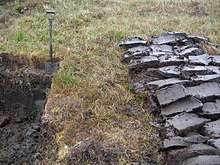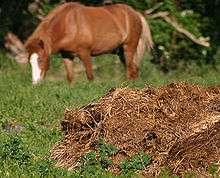Organic fertilizer
Organic fertilizers are fertilizers derived from animal matter, animal excreta (manure), human excreta, and vegetable matter (e.g. compost and crop residues).[1] Naturally occurring organic fertilizers include animal wastes from meat processing, peat, manure, slurry, and guano.
In contrast, the majority of fertilizers used in commercial farming are extracted from minerals (e.g., phosphate rock) or produced industrially (e.g., ammonia). Organic agriculture, a system of farming, allows for certain fertilizers and amendments and disallows others; that is also distinct from this topic.
Examples and sources

The main organic fertilizers are, peat, animal wastes (often from slaughter houses), plant wastes from agriculture, and treated sewage sludge.[1]
Mineral
By many definitions, minerals are separate from organic materials. However, certain organic fertilizers and amendments are mined, specifically guano and peat. Other mined minerals are fossil products of animal activity, such as greensand (anaerobic marine deposits), some limestones (fossil shell deposits), and some rock phosphates (fossil guano).
Peat, a precursor to coal, offers no nutritional value to the plants, but improves the soil by aeration and absorbing water. It is sometimes credited as being the most widely use organic fertilizer and by volume is the top organic amendment.

Animal sources
Animal sourced materials include both animal manures and residues from the slaughter of animals. Manures are derived from milk-producing dairy animals, egg-producing poultry, and animals raised for meat and hide production. When any animal is butchered, only about 40% to 60% of the live animal is converted to market product, with the remaining 40% to 60% classed as by-products. These by-products of animal slaughter, mostly inedible -- blood, bone, feathers, hides, hoofs, horns, -- can be refined into agricultural fertilizers including bloodmeal, bone meal[1] fish meal, and feather meal.
Chicken litter, which consists of chicken manure mixed with sawdust, is an organic fertilizer that has been proposed to be superior for conditioning soil for harvest than synthetic fertilizers.[2]
Plant
Processed organic fertilizers include compost, humic acid, amino acids, and seaweed extracts. Other examples are natural enzyme-digested proteins. Decomposing crop residue (green manure) from prior years is another source of fertility.
Other ARS studies have found that algae used to capture nitrogen and phosphorus runoff from agricultural fields can not only prevent water contamination of these nutrients, but also can be used as an organic fertilizer. ARS scientists originally developed the "algal turf scrubber" to reduce nutrient runoff and increase quality of water flowing into streams, rivers, and lakes. They found that this nutrient-rich algae, once dried, can be applied to cucumber and corn seedlings and result in growth comparable to that seen using synthetic fertilizers.[3]
Treated sewage sludge
Sewage sludge, also known as biosolids, is effuent that has been treated, blended, composted, and sometimes dried until deemed biologically safe. As a fertilzer it is most commonly used on non-agricultural crops such as in silviculture or in soil remediation. Use of biosolids in agricultural production is less common, and the National Organic Program of the USDA (NOP) has ruled that biosolids are not permitted in organic food production in the U.S.; while biologic in origin (vs mineral), sludge is unacceptable due to toxic metal accumulation, pharmaceuticals, hormones, and other factors.[4]
With concerns about human borne pathogens coupled with a growing preference for flush toilets and centralized sewage treatment, biosolids have been replacing night soil (from human excreta), a traditional organic fertilizer that is minimally processed.

See also
- Biofertilizer
- Organic hydroponic solutions
- Reuse of excreta
References
- Heinrich Dittmar, Manfred Drach, Ralf Vosskamp, Martin E. Trenkel, Reinhold Gutser, Günter Steffens "Fertilizers, 2. Types" in Ullmann's Encyclopedia of Industrial Chemistry, 2009, Wiley-VCH, Weinheim. doi:10.1002/14356007.n10_n01
- "Researchers Study Value of Chicken Litter in Cotton Production". 23 July 2010.
- "Algae: A Mean, Green Cleaning Machine". USDA Agricultural Research Service. 7 May 2010.
- "Organic Farming | Agriculture | US EPA". Epa.gov. Retrieved 2012-01-09.
- "Managing Potassium for Organic Crop Production" (PDF). CO State Extension.
- "Phosphorus Fertilizers for Organic Farming Systems". CO State Extension.
- "Maintaining Soil Fertility in an Organic Fruit and Vegetable Crops System". University of MN Extension.
- "Organic Materials as *Nitrogen Fertilizers". CO State Extension.
| Wikimedia Commons has media related to Fertilizer. |